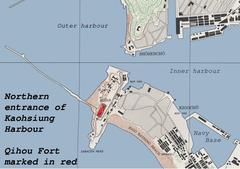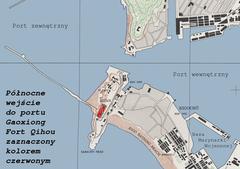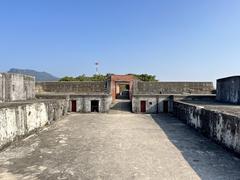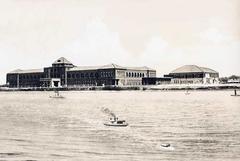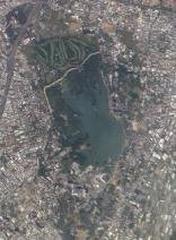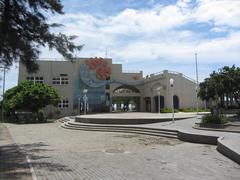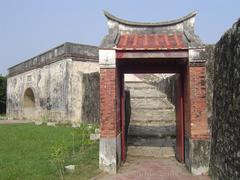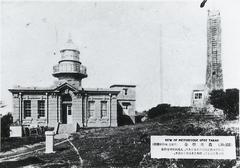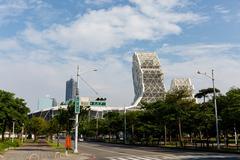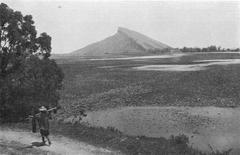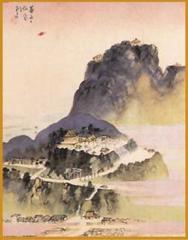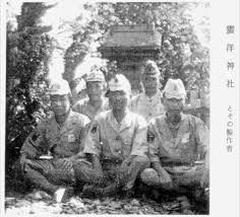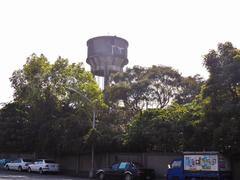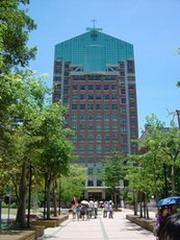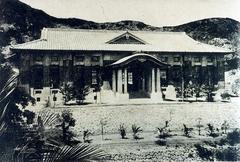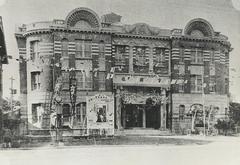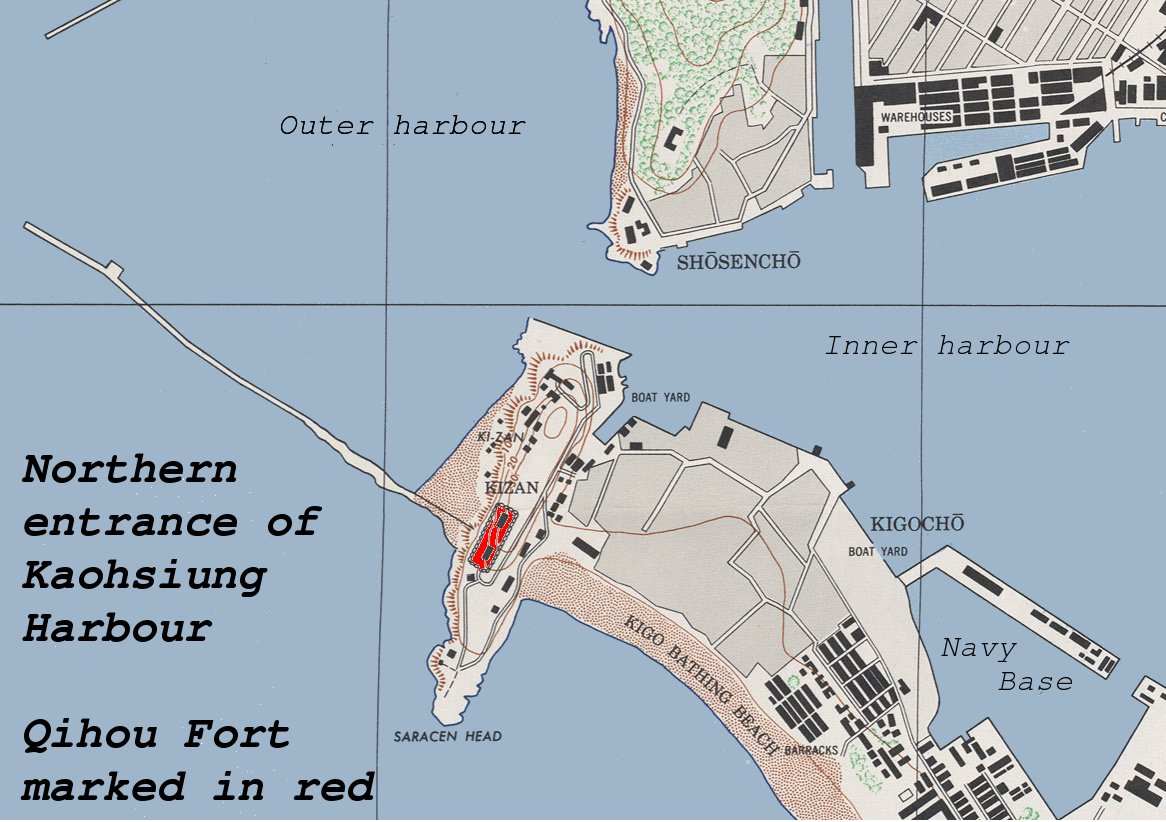
Visiting Cihou Fort: History, Tickets, and Tips
Publication Date: 18/07/2024
Introduction to Cihou Fort
Cihou Fort, also known as Qihou Fort, is a historic military fortification nestled in the Cijin District of Kaohsiung, Taiwan. Built in 1875 during the Qing Dynasty under the direction of Liu Mingchuan, the first governor of Taiwan, its primary role was to safeguard the port of Kaohsiung from naval invasions and secure the Taiwan Strait (Taiwan Tourism Bureau). The fort’s strategic position on Cihou Mountain provided a commanding view over the Taiwan Strait and the entrance to Kaohsiung Harbor, making it a critical defense point. The fusion of traditional Chinese and Western military architectural elements in its construction is a testament to the military engineering techniques of the late 19th century (Kaohsiung Travel).
Throughout its history, Cihou Fort has played an instrumental role in several significant conflicts, notably during the Sino-French War (1884-1885) where it helped repel French naval forces attempting to blockade the port (Academia Sinica). The fort continued to maintain its strategic importance during the Japanese occupation following the Treaty of Shimonoseki in 1895, wherein it underwent significant modernization (National Museum of Taiwan History). Post-World War II, Taiwan’s return to the Republic of China saw the fort’s military relevance decline, ultimately leading to its designation as a national historic site in 1988 (Cultural Heritage Department).
Today, Cihou Fort stands as a preserved cultural heritage site, offering visitors a rich historical narrative and panoramic views of Kaohsiung Harbor and the Taiwan Strait. Whether you are a history enthusiast or a casual traveler, this guide will provide you with comprehensive information for your visit, including Cihou Fort visiting hours, ticket information, and travel tips.
Contents Overview
- Introduction
- Early Construction and Strategic Importance
- Architectural Design and Features
- Role in the Sino-French War
- Japanese Occupation and Modernization
- Post-World War II and Decline
- Restoration and Tourism
- Visitor Information
- Cihou Fort Visiting Hours
- Cihou Fort Tickets
- Accessibility
- Travel Tips
- Special Events and Guided Tours
- Photographic Spots
- Nearby Attractions
- Cultural Significance and Legacy
- Visitor Experience
- Conclusion
- FAQ
Explore the Rich History and Visitor Guide to Cihou Fort in Kaohsiung
Early Construction and Strategic Importance
Cihou Fort was constructed under the direction of Liu Mingchuan, the first governor of Taiwan. Its primary purpose was to protect the vital port of Kaohsiung from naval attacks and to secure the Taiwan Strait, a crucial maritime route (Taiwan Tourism Bureau).
Architectural Design and Features
The fort’s design reflects a blend of traditional Chinese and Western military architecture. The structure is primarily composed of brick and stone, featuring thick walls and strategically placed gun emplacements. The layout includes a main gate, barracks, ammunition depots, and several artillery platforms. The main gate is adorned with traditional Chinese architectural elements, including intricate carvings and inscriptions (Kaohsiung Travel).
Role in the Sino-French War
Cihou Fort played a significant role during the Sino-French War (1884-1885), helping to repel French naval forces attempting to blockade the port of Kaohsiung. This defense underscored the strategic importance of Cihou Fort and its effectiveness in safeguarding Taiwan’s maritime interests (Academia Sinica).
Japanese Occupation and Modernization
Following the Treaty of Shimonoseki in 1895, Taiwan was ceded to Japan. During the Japanese occupation, Cihou Fort underwent significant modernization, including upgraded artillery and reinforced defensive structures. These enhancements ensured that the fort remained a formidable defensive position (National Museum of Taiwan History).
Post-World War II and Decline
After World War II, Taiwan was returned to the Republic of China, causing Cihou Fort’s military significance to diminish. The fort was eventually decommissioned and fell into disrepair. Recognizing its historical value, efforts were made to preserve the site as a cultural heritage landmark. In 1988, Cihou Fort was designated as a national historic site by the Taiwanese government (Cultural Heritage Department).
Restoration and Tourism
In recent years, Cihou Fort has undergone extensive restoration to preserve its historical integrity and make it accessible to the public. Restoration efforts have focused on repairing structural damage, restoring original architectural features, and installing informative displays. Today, Cihou Fort is a popular tourist attraction, offering panoramic views of Kaohsiung Harbor and the Taiwan Strait (Kaohsiung City Government).
Visitor Information
- Cihou Fort Visiting Hours: The fort is open daily from 9:00 AM to 5:00 PM.
- Cihou Fort Tickets: Entry is free of charge.
- Accessibility: The fort has several ramps and paved pathways, making it accessible to visitors with mobility issues.
- Travel Tips: Wear comfortable shoes as the fort grounds can be uneven. Don’t forget your camera for some spectacular shots!
Special Events and Guided Tours
Cihou Fort occasionally hosts special events and historical reenactments. Guided tours are available in multiple languages, providing in-depth insights into the fort’s history and architecture.
Photographic Spots
The fort’s elevated position provides stunning views of the surrounding area. Popular spots include the main gate, the artillery platforms, and the panoramic view of Kaohsiung Harbor.
Nearby Attractions
After exploring Cihou Fort, take a stroll down Cijin Old Street for local delicacies and souvenirs. Other nearby attractions include the Cijin Windmill Park and the Cijin Shell Museum.
Cultural Significance and Legacy
Cihou Fort is a testament to Taiwan’s rich military history and a symbol of the island’s resilience. The fort’s preservation as a cultural heritage site serves as a reminder of the various historical periods that have shaped Taiwan. The site continues to attract historians, tourists, and locals alike, providing a tangible connection to Taiwan’s past (Taiwan Cultural Portal).
Visitor Experience
Visitors can explore the well-preserved fortifications, walk along the ancient walls, and visit the various gun emplacements and barracks. Informative plaques and guided tours offer detailed explanations of the fort’s history and architectural features. The fort’s elevated position provides stunning views, making it a popular spot for photography and sightseeing. Additionally, the nearby Cijin Old Street offers a variety of local delicacies and souvenirs (Kaohsiung Travel Guide).
Conclusion
Cihou Fort stands as a significant historical and cultural landmark in Kaohsiung, Taiwan. Its rich history, architectural features, and strategic importance make it a must-visit destination for those interested in Taiwan’s military heritage. The ongoing preservation efforts ensure that future generations can continue to appreciate and learn from this remarkable site. For more information, download the Audiala app or follow us on social media for updates (Taiwan Tourism Bureau).
FAQ
Q: What are the visiting hours of Cihou Fort?
A: The fort is open daily from 9:00 AM to 5:00 PM.
Q: How do I get tickets to Cihou Fort?
A: Entry to Cihou Fort is free of charge.
Q: Is Cihou Fort accessible for visitors with mobility issues?
A: Yes, the fort has several ramps and paved pathways.
Q: Are there any guided tours available?
A: Yes, guided tours are available in multiple languages and can be booked on-site.
Q: What are some nearby attractions?
A: Nearby attractions include Cijin Old Street, Cijin Windmill Park, and Cijin Shell Museum.
Summary and Key Points
Cihou Fort stands as a monumental testament to Taiwan’s rich military history and resilience. Its well-preserved architecture, strategic historical significance, and panoramic views make it a must-visit destination in Kaohsiung. The fort’s blend of traditional Chinese and Western military design, along with its pivotal role in historical conflicts such as the Sino-French War, underscores its historical importance (Academia Sinica).
The extensive restoration efforts have not only preserved its structural integrity but also enhanced its accessibility for visitors, making it an enriching experience for all. The fort’s elevation provides breathtaking views, making it a popular spot for photography and sightseeing. Its proximity to other attractions like Cijin Old Street, Cijin Windmill Park, and the Cijin Shell Museum further enriches the visitor experience (Kaohsiung City Government).
As a national historic site, Cihou Fort continues to educate and inspire visitors about Taiwan’s multifaceted history. The ongoing preservation efforts ensure that future generations can continue to appreciate and learn from this remarkable landmark. For more detailed information and updates, visitors are encouraged to explore the official Kaohsiung tourism website.
Sources and References
- Taiwan Tourism Bureau. (n.d.). Explore the Rich History and Visitor Guide to Cihou Fort in Kaohsiung. Retrieved from https://eng.taiwan.net.tw/
- Kaohsiung Travel. (n.d.). Architectural Design and Features. Retrieved from https://khh.travel/
- Academia Sinica. (n.d.). Role in the Sino-French War. Retrieved from https://www.sinica.edu.tw/
- National Museum of Taiwan History. (n.d.). Japanese Occupation and Modernization. Retrieved from https://www.nmth.gov.tw/
- Cultural Heritage Department. (n.d.). Post-World War II and Decline. Retrieved from https://www.boch.gov.tw/
- Kaohsiung City Government. (n.d.). Restoration and Tourism. Retrieved from https://www.kcg.gov.tw/
